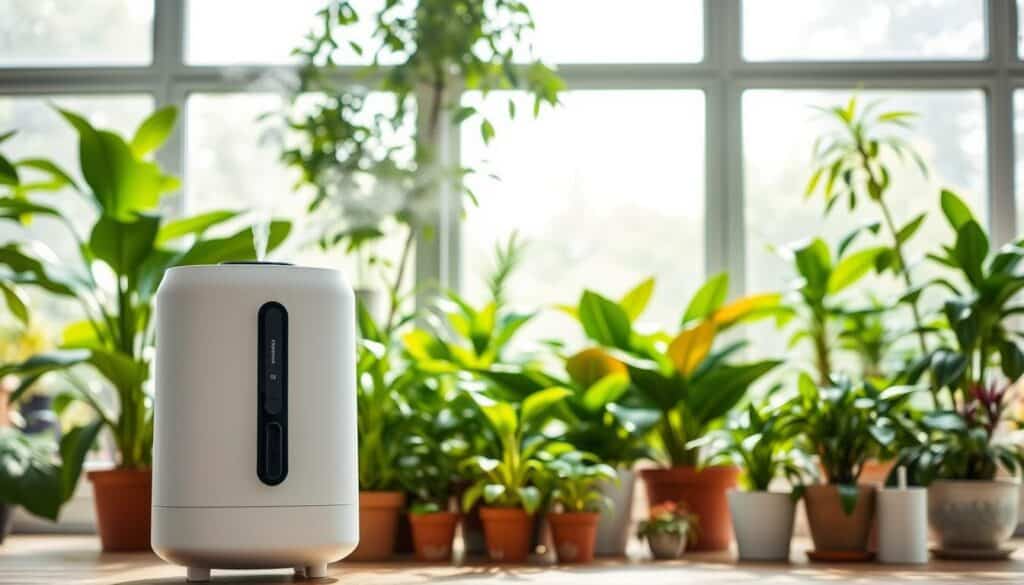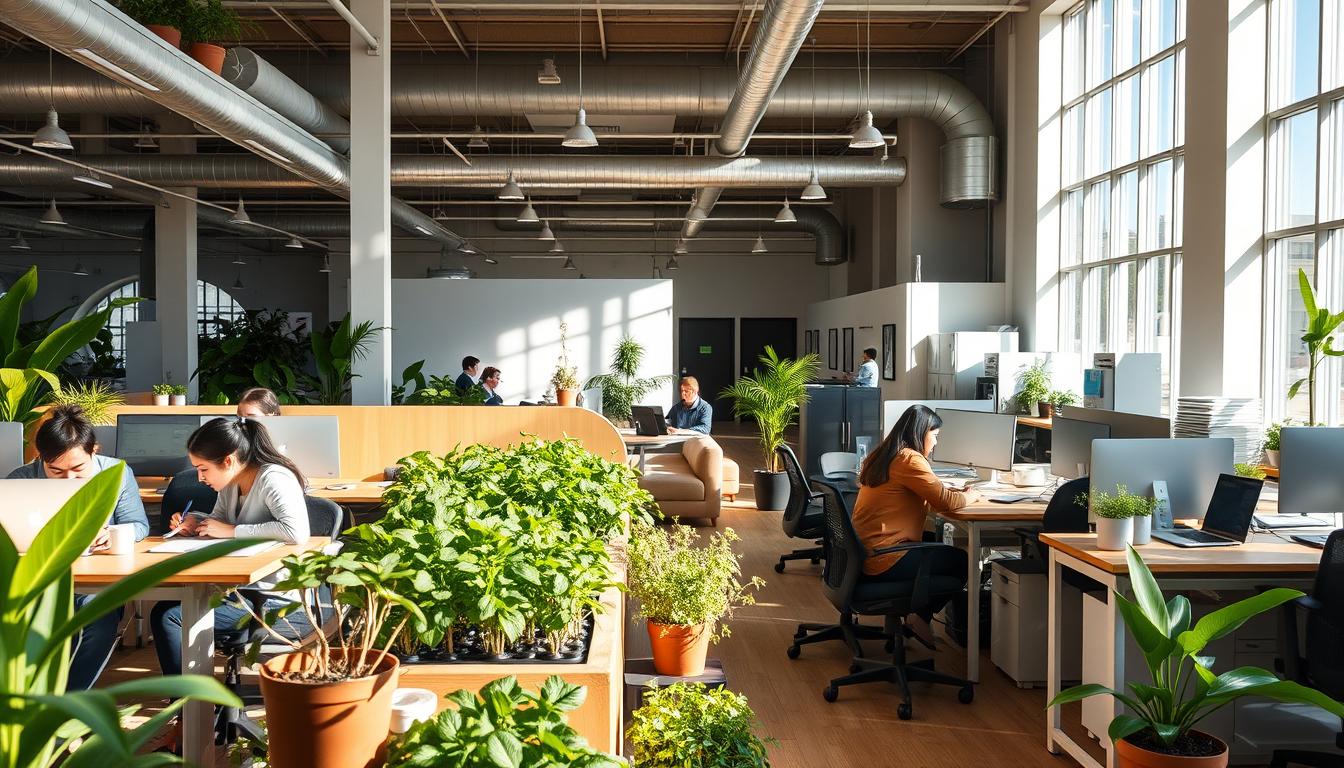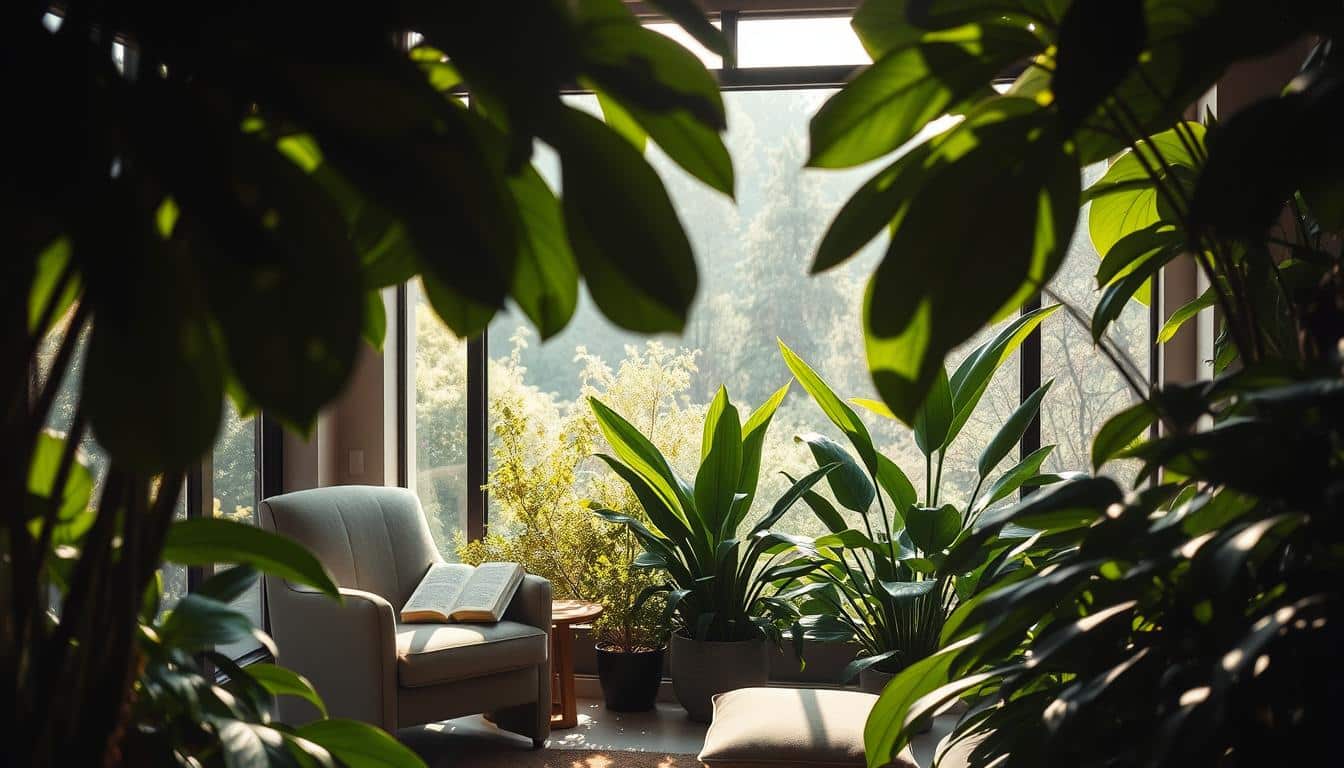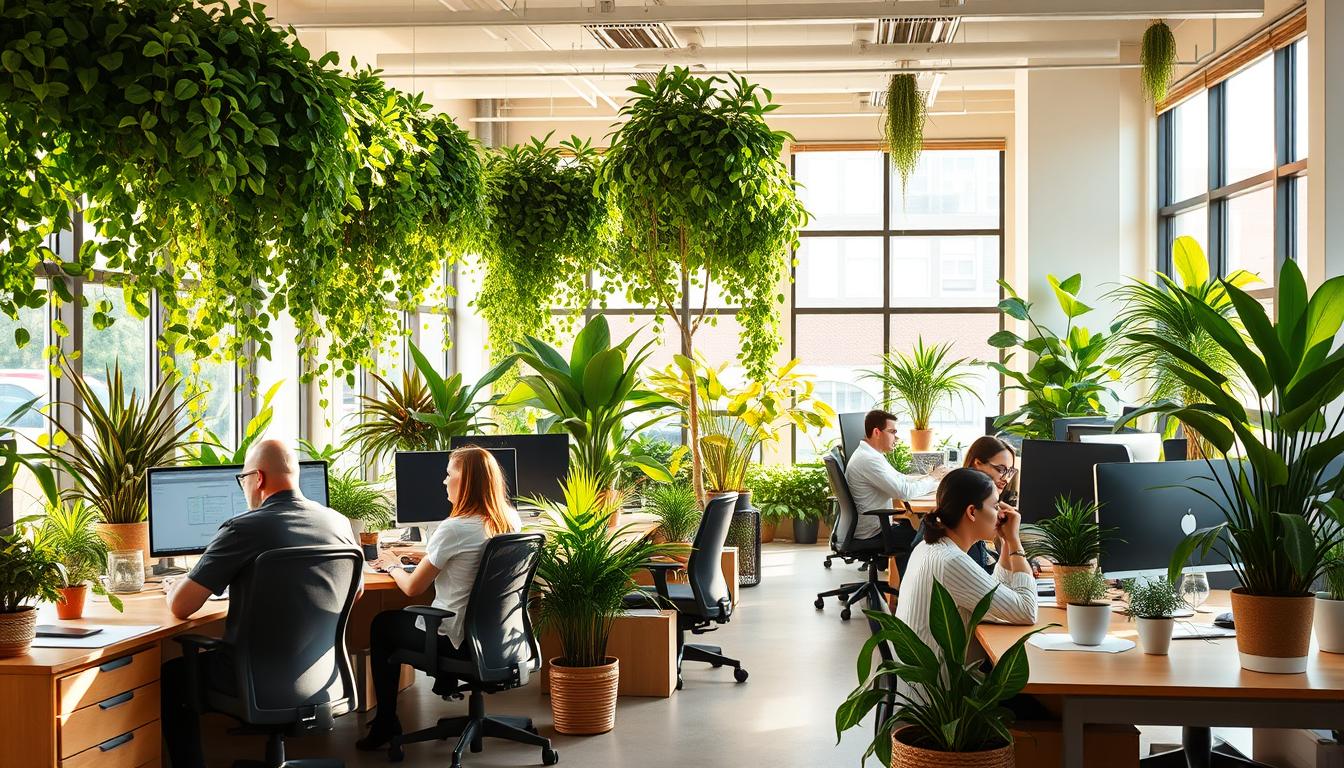Indoor gardening seeks perfect conditions for lush, healthy plants. Vegetative humidity stabilization is key for success. It’s about keeping moisture levels steady. This helps plants grow well.
Managing humidity boosts nutrient uptake and optimizes photosynthesis. These steps are crucial for strong plant growth. We’ll look at setting the right humidity and temperature for every growth stage. This leads to better yields and a flourishing indoor garden.
Introduction to Indoor Gardening and Humidity
Indoor gardening is now a popular hobby, bringing the outdoors inside. It lets growers cultivate various plant types throughout the year. Understanding how to manage humidity is key. The right humidity levels are vital for the health and growth of plants.
A grow tent is a perfect tool for this. It offers a space where conditions are just right for growth. Controlling humidity inside it avoids mold and helps plants get enough moisture. This makes indoor gardening more than just a pastime.

Understanding the Importance of Humidity for Plant Health
Humidity is key for plant health and growth. It impacts important processes like photosynthesis and nutrient uptake. The right humidity levels help indoor gardens flourish. But, the wrong levels can cause growth problems.
The Role of Humidity in Photosynthesis
Plants use photosynthesis to turn light into energy. Humidity greatly affects this process. High humidity helps plants better absorb water. This lets them use light more efficiently, boosting their growth and energy.
Impact of Humidity on Nutrient Absorption
Nutrient absorption in plants is linked to humidity. With the right humidity, plants draw in nutrient-rich water easily. Too little humidity means they can’t get enough nutrients, harming their health. Too much can lead to root rot and other issues.
Optimal Humidity Levels for Different Plant Stages
Each growth phase of a plant needs its own humidity level to grow strong and healthy. Knowing these details helps to grow plants successfully through all their stages.
Seedling Stage Needs
Seedlings do best when the air is kept between 60-70% humid. This helps keep the moisture they need, which is vital for growing roots. With the right humidity, young plants can soak up water better, giving them a strong start.
Vegetative Stage Requirements
When plants enter the vegetative stage, humidity should be between 40-60%. This level is great for leaf growth and helps plants breathe water through their leaves properly. Keeping humidity in this range is key for making sure the leaves grow well, which helps with photosynthesis and the plant’s overall health.
Flowering Stage Conditions
During the flowering stage, it’s best to have lower humidity, about 40-50%. Lower humidity keeps mold and mildew away, which is very important when plants are blooming. The right moisture level creates a healthier space for flowers to bloom well, lowering the chance of pests and disease.
What is Vegetative Humidity Stabilization?
Vegetative humidity stabilization keeps the moisture levels steady in an indoor garden. It’s very important because too much change can stress plants out. These changes can make them sick or lower the number of fruits and vegetables they produce. Indoor gardeners must understand how to manage humidity to keep plants happy at all growth stages.
To stabilize humidity well, gardeners can use different methods. These methods help create the perfect environment for strong plant growth. By keeping an eye on and changing the moisture levels, indoor gardeners can make their plants healthier and more productive. Focusing on humidity helps make indoor gardening successful and rewarding.
Techniques for Achieving Humidity Stabilization
Getting the humidity right is key in indoor gardening. There are various ways to keep moisture levels perfect for plants. These methods make sure your plants get just the right amount of humidity to thrive.
Using Humidifiers and Dehumidifiers
Humidifiers add moisture to the air, which plants love during dry months. They make the environment ideal for humidity-loving plants. Meanwhile, dehumidifiers pull out too much moisture, stopping mold and mildew. Using both devices right keeps your garden’s humidity just perfect.
Watering Techniques to Manage Humidity
The way you water plants affects the air’s moisture. The “wet-dry” cycle is key. It means watering plants well, then letting the soil dry before watering again. This keeps humidity in check nicely.
Ventilation Systems for Humidity Control
Good airflow is a must for the right humidity in indoor gardens. Ventilation systems help by bringing in fresh air and taking out extra moisture. This keeps humidity stable and gives plants the carbon dioxide they need for food-making.
Measuring Humidity Levels Accurately
Getting humidity levels right is key for indoor gardening success. Knowing how to track moisture affects plant well-being and growth. A good hygrometer is vital for precise humidity measurement. It’s important to place it correctly, ideally in the middle of your grow area, for best results.
Tools for Humidity Measurement
Choosing the right tools is important for measuring moisture. When checking humidity, think about these options:
- Analog hygrometers: Simple and straightforward, but may lack precision.
- Dew point hygrometers: Provide a more detailed understanding of moisture in the air.
- Digital hygrometers: Often offer high accuracy and additional features such as temperature readings.
Interpreting Humidity Data
Understanding humidity data helps gardeners manage their plants better. Knowing when to adjust watering or air flow comes from monitoring moisture. Keeping track of humidity benefits plant health and helps them grow better. By staying vigilant, gardeners can give plants the care they need through all their growth stages.
How Temperature Affects Humidity Levels
Temperature and humidity are important for indoor gardening. Warm air holds more moisture than cool air. So, when it gets hotter, humidity can change a lot. Knowing this helps keep plants growing well.
The Relationship Between Temperature and Humidity
The heat impacts how much moisture air can hold. When it’s warmer, the air can keep more water. So, in hot times, it’s key to watch the humidity to keep plants happy.
Effects of Temperature Fluctuations on Plant Growth
Changes in temperature can hurt plant growth. It messes with important things like making food and taking in nutrients. Plants get stressed if it gets too hot or cold. Keeping the temperature around 70-75°F helps keep humidity steady. This makes plants grow strong and healthy.
Strategies for Controlling Temperature in a Grow Tent
Keeping the right temperature in a grow tent is key for happy plants. Using good ventilation techniques greatly helps the inside conditions. This means heat spreads out well, avoiding hot spots that harm plants. So, picking the right ventilation can really make a difference in growing success.
Effective Ventilation Techniques
For better temperature control, try these ventilation ideas:
- Using inline fans to create a continuous flow of fresh air.
- Incorporating oscillating fans to improve air circulation.
- Setting up exhaust fans to expel hot air and draw in cooler air.
- Utilizing vents to allow for passive air movement when needed.
Choosing the Right Heating Equipment
Picking the right heaters is vital for temperature control. Growers often choose oil-filled radiators or radiant heaters. These give off a steady warmth without making the air too dry, which can hurt the plants. Always make sure the heater fits your grow tent’s size to warm it up evenly.
Common Humidity Challenges in Indoor Gardening
Many indoor gardeners often struggle with humidity issues that can hurt their plants. Having the right humidity is key for plants to grow well. Too much moisture can cause mold, and not enough can stress plants out, leading to wilting and dropping leaves.
Overwatering plants can make humidity levels too high. This makes the air too moist, which isn’t good for the plants. Poor airflow makes these humidity problems worse by keeping the air still and full of moisture.
To beat humidity problems in indoor gardens, it’s vital to manage moisture levels well. Gardeners can keep their plants happy and healthy by tackling these issues early. Checking humidity often and adjusting how much you water plants can prevent sickness in plants.
Advanced Techniques for Managing Humidity
Advanced humidity management is key to indoor gardening success. By using environmental controllers, you can closely watch and adjust humidity. This makes sure your plants stay healthy. These tools help keep the environment stable, even when conditions change during a plant’s growth.
Environmental Controllers and Monitoring Systems
Environmental controllers are essential for managing humidity well. They use sensors and automation to keep an eye on temperature and humidity around the clock. This means they can turn humidifiers or dehumidifiers on and off when needed. This keeps plant growth from being harmed by too much or too little moisture. There’s a range of controllers out there, so you can find one that fits your gardening needs. This ensures your plants grow in the best possible conditions.
Data Logging for Humidity Trends
Adding data logging helps you understand humidity changes over time. By looking at past data, gardeners can see how the environment affects their plants. This lets them adjust conditions to better suit plant growth. Data logging not only tracks humidity but also shows how it relates to how well plants do. This helps you improve your growing methods for healthier plants.
Conclusion
To get the best out of indoor plants, it’s key to balance the moisture in the air they breathe. Different stages of growth need different levels of humidity and warmth. It’s vital to keep an eye on these elements, as small changes can make a big difference in how well plants grow and produce.
Using tools like humidifiers and dehumidifiers helps control the air around the plants. Also, making sure the place is well-ventilated and watering the plants right plays a huge part. Taking care of these details helps plants stay healthy and grow strong all year round.
Stabilizing humidity for plants indoors is super important. It helps garden lovers grow vibrant, healthy plants. This leads to impressive harvests and a satisfying experience in gardening.



